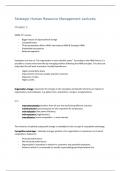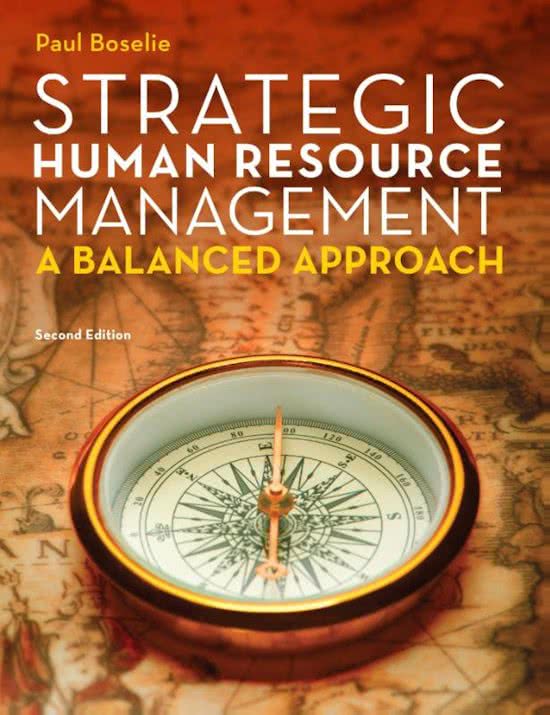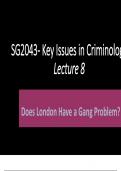Strategic Human Resource Management Lectures
Chapter 1
SHRM 21st century
- Bigger impact of organizational change
- Competitiveness
- Three perspectives (Micro HRM, International HRM & Strategic HRM)
- Stakeholder perspective
- Balanced approach
Employees are seen as “the organization’s most valuable assets”. According to the HRM theory, it is
possible to create several benefits by managing workers following the HRM principles. This does not
imply that this will work in practice. Possible benefits are:
- Higher productivity levels
- Improvement of service quality towards customers
- Expansion of sales
- Higher profits
Organization change: represents the changes in the nowadays working life which has an impact on
organizations and employees. E.g. global crisis, acquisitions, mergers, reorganizations.
5 I’s:
- Internationalization (workers from all over the world bring different cultures).
- Individualization (personal goals are also important for employees).
- Informalization (low power distance).
- Informatization (digitalization).
- Intensification (more competition -> more intense).
The relevance of optimal coping with change is embedded in the concept of competitive advantage.
Competitive advantage = relatively stronger position of an organization in comparison to its direct
competitors. Related to:
- Financial performance
- Non-financial performance
- Organization’s reputation in relation to customers and potential employees.
- Extent to which it is sustainable or socially responsible/green/triple bottom line.
,The competitive advantage is a concept that:
- Tells us about how well the organization is doing in comparison to others in the same branch
of industry or in the same region.
- Says that a business has a competitive advantage if the employees and all different
stakeholders in the business environment know how to cope with organizational change.
- Human resources determine at least partly the competitive advantage of a business.
- Is important for organizational survival.
HRM = involves management decisions related to policies and practices that together shape the
employment relationship and are aimed at achieving individual, organizational and societal goals.
MHRM IHRM SHRM
Subfield aimed at studying the Studying the shaping of the Studying the shaping of the
shaping of the employment employment relationship in an employment relationship,
relationship at individual level. international context with internal and external
Recruitment, selection, special attention to HRM for organizational context in an
induction, socialization, expatriates, in large MNC’s attempt to gain sustainable
training and development. and IGO’s. competitive advantage.
Deals with inflow, Is concerned with HRM in Special attention to the
throughflow, and outflow of multinational companies potential alignment of fit
employees. (MNCs) and HRM across between the business strategy
borders and HRM strategy.
Covers the sub functions of HR Focused on issues such as the Focuses on issues of linking
policy and practice including transferability of HR practices HRM to the business strategy.
recruitment & selection, across business units in
induction & socialization, and different countries.
training & development.
Related to the studies in The concept of ‘fit’ plays a
Organizational Behaviour and central role within SHRM.
Occupational Psychology,
focused on impact of single HR
practices on employee
attitudes and behaviours
3 perspectives in studying SHRM practices
- A multi-actor perspective: takes the interests of multiple stakeholders including employees,
colleagues, managers and shareholders into account.
- A broad societal view with an emphasis on different institutional contexts, for example, on
the level of branches of industry, regions and countries.
- A multi-level perspective including the individual employee perspective and the strategic
organizational perspective.
,Paauwe (2004)
- Human resources are more than just ‘resources’: people have feelings, emotions, interests,
norms and values.
- HRM is not concerned solely with financial performance, but there is a broader responsibility
covering stakeholders management and relating (labour) legislation: such as well-being,
happiness, and health.
- HRM focuses on the exchange relationship (physical contract) between employee and
organization;
- The employment relationship shaping takes place in an area with tension between:
Added values: soft HRM focused on the human side of organizing (resource).
Moral values: hard HRM focused on economics (human)
4 contract types in exchange relationship:
1. Legal contract: determines rights and obligations of both parties (vacation days).
2. Economic/ transactional contract (salary and working hours).
3. Psychological contract: unwritten expectations, from both actors (all things that are not
written down).
4. Sociological contract: social aspects in relations (bond with colleagues).
Boxall & Purcell (2008)
- HRM covers all workforce groups, including core employees, peripheral employees and
contingent workers;
Core employees = people who work permanently in a company and are under contract.
Peripheral employees/ contingent workers = people who often work temporarily in a
company (cleaning team). Are often neglected because many companies only have
special programs for core employees, here motivation can decrease.
- HRM involves line and specialist managers, and is not solely aimed at employees;
- HRM is all about managing work and people, collectively and individually;
- HRM is embedded in industries and societies.
HRM practices:
- Recruitment and selection
- Training and development
- Appraisal and rewards
- Promotion
- Participation
- Job autonomy
- Job rotation
- Job design
Tasks (job enlargement).
Responsibilities (job enrichment)
, Traditional HRM model: focuses only on valuable employees.
New HRM model: focuses on the whole workforce.
Anglo-Saxon / Anglo-American model (USA): focuses on creating shareholders value in terms of
profits and market value (Hard HRM).
Rhineland model (Europe): acknowledges multiple shareholders affecting the employment
relationship in organizations (Soft HRM).
The balanced approach:
With globalization and rising competition, businesses increasingly recognize that lasting competitive
advantage requires balancing market demands with institutional pressures. This balanced approach
combines economic and institutional insights to promote organizational sustainability.
- Organizational success is achieved when both its financial and societal performance are
above average in its specific operating environment.
- A narrow, unitarist approach to designing the employment relationship leads to poor people
management. In contrast, considering stakeholders' interests and a broader perspective
results in effective people management.
- The goals of the individual employee, the organizational goals, and the societal goals have to
be in line with each other.
Bolman & Deal (2008); 4 perspectives for studying organizations that can contribute to a better
understanding and cognition of organizations and HRM realities:
1. Structural frame: seeks and understanding of the structural parts of an organization (rules,
roles, goals, technology)
2. HR frame: psychological background for needs, skills, and relationships of those who are
involved.
3. Political frame: an examination of the use of power (power, conflict, competition).
4. Symbolic frame: meaning and identity of individuals and organization (culture, stories).
SHRM is typically examined through structural and HR frames, while the political and symbolic
frames are often overlooked. A balanced approach combines all these perspectives, as each offers a
unique view, creating a more complete understanding of HRM.






